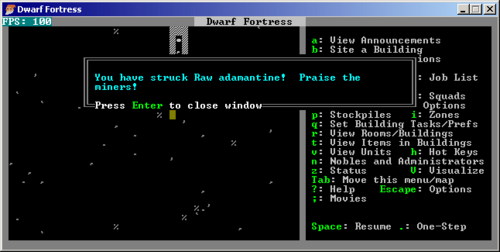- v50 information can now be added to pages in the main namespace. v0.47 information can still be found in the DF2014 namespace. See here for more details on the new versioning policy.
- Use this page to report any issues related to the migration.
40d:Adamantine
| ||||||||||||||||||||||||||||||||||||
| Uses | ||||||||||||||||||||||||||||||||||||
|---|---|---|---|---|---|---|---|---|---|---|---|---|---|---|---|---|---|---|---|---|---|---|---|---|---|---|---|---|---|---|---|---|---|---|---|---|
| Ore | ||||||||||||||||||||||||||||||||||||
| Properties | ||||||||||||||||||||||||||||||||||||
| ||||||||||||||||||||||||||||||||||||
Adamantine is by far the most rare and valuable metal in the game. It can only be found in mountainous areas, and only in small amounts. Care should be taken if it is found, since digging down several levels through it will lead you to a spoiler, which can wipe out even a mature, heavily defended fortress.
Discovery of adamantine will also bring the attention of the King, who will immigrate to your fortress once news of your discovery reaches him. If you have not otherwise met the criteria for attracting the King, he will arrive "disguised as a peasant." His requirements appears to be the same in any case, so be prepared!
Location
To start in a location which has adamantine (and the accompanying demon pits), you must start on a mountain tile (∆,∆,▲,▲,▲,▲,^,^,^) or volcano tile (^) in the Region map. The adamantine and pits will be located somewhere within the Local map of that region. It is more likely to be found on a Local map square which also shows as mountain. The adamantine will occupy only one Local square, though the demon pits may extend beyond it.
Deposits are not visible on the Region/World maps or the Local maps by default, but can be turned visible by setting SHOW_EMBARK_OTHER to ALWAYS in init.txt, in which case they appear as £ on the local embark map.
Veining
Curiously, adamantine veins tend to span z-levels more than the xy planes. Finding a short section of adamantine only 2x1 or 3x1, dig up or down a z-level and you'll probably find another short section. To view examples of this phenomenon, check out the DFMA Point of Interest and a movie recording the layout of a vein.
Processing
Adamantine strands are extracted from raw adamantine at a craftsdwarf's workshop. The strand extraction labor must be enabled for a dwarf to perform the extraction. The process is extremely slow for an unskilled laborer. Adamantine strands are worth 1800☼ each, while the raw adamantine is worth 750. 1 ore => 1 strand => 1 wafer.
Subsequent processing of the strands requires no adamantine-specific skills or labor permissions. Adamantine strands are processed into adamantine wafers at any smelter. Adamantine wafers are worth 1500☼ each - curiously, less than the strands they are smelted from. Adamantine wafers are treated much like bars of other metal, and can be forged into a variety of useful items. Adamantine strands may also be woven into cloth using the Weave Metal Cloth task in a loom. Adamantine strands may be dyed, but if they are melted into wafers the they will return to their normal color and value.
Forging things out of adamantine requires a number of wafers equal to item's MATERIAL_SIZE. This is usually about three times as many as are needed for constructions with bars of other metals, since one metal bar counts for 3 MATERIAL_SIZE. For instance, plate mail has [MATERIAL_SIZE:9] and normally requires three metal bars to forge; adamantine plate mail requires nine adamantine wafers. Helm has [MATERIAL_SIZE:2] and normally requires one metal bar to forge; adamantine helm requires two adamantine wafers. Large furniture takes 9 full wafers and small furniture (buckets, chains) takes 3 full wafers (compare to 3 bars and 1 bar respectively for other metals). Miscellaneous craft items are only 1 wafer, and you still get a full set of 3 goblets. This makes goblets far and away the best option if you want to maximize your adamantine wealth, even moreso than in other materials.
Note that if you try to melt down adamantine objects, you recover wafers at the same rate that you would normally recover bars, so trying to melt down lower-quality adamantine items to reforge them gets prohibitively expensive in a hurry--adamantine plate mail takes 9 wafers to forge and yields slightly less than a single wafer when melted for scrap.
Uses
Adamantine is so valuable that a special message pops up when you discover a vein of it.
Raw adamantine may also be processed into stone goods in the same way as other economic stone. In its raw form, it has a value multiplier of x250 (as opposed to adamantine metal, which is x300). Raw adamantine blocks are worth 1250☼.
Adamantine items are incredibly light: they weigh about 2.5% as much as an equivalent article crafted from iron. Weapons and armor made from adamantine are 5 times stronger than equivalent iron objects.
Adamantine is one of the few magma-safe materials. Raw adamantine is the only stone, aside from bauxite, that can be used to make magma-safe mechanisms. (To do this, you must lift the restrictions on its use via the Stone submenu of the status screen.) Mechanisms can also be made from a single[Verify] adamantine wafer at a forge or magma forge, under "trap components" -- this cannot be done with any other metal.
Storage
Raw Adamantine is stored in stone stockpiles with "Raw Adamantine" enabled in that stockpile's 'other stone' category.
However once strands are extracted, they are stored in a cloth pile. It is unfortunately impossible to directly segregate adamantine from plant fiber and silk cloth, because all cloth apparently counts as non-plant/animal products as far as the game is concerned, and adamantine does not appear as a thread/cloth type in the cloth custom stockpile menu. To create a stockpile for adamantine strands designate a cloth stockpile set to accept no types of thread or cloth and tell this stockpile to take from all other cloth stockpiles.
Wafers are stored in bar/block piles with adamantine enabled. All other goods can be stored in any stockpile with the adamantine metal enabled.
